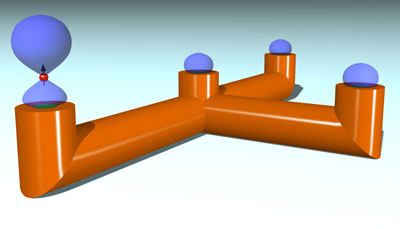| Posted: Jun 25, 2014 |
World's first magnetic hose created
|
|
(Nanowerk News) An international team of scientists led by researchers from the Department of Physics of the Universitat Autònoma de Barcelona has developed a material which guides and transports a magnetic field from one location to the other, similar to how an optical fibre transports light or a hose transports water.
|
|
The magnetic hose designed by the researchers consists of a ferromagnetic cylinder covered by a superconductor material, a surprisingly simple design given the complicated theoretical calculations and numerous lab tests it had to undergo. A 14-centimeter prototype was built, which transports the magnetic field from one extreme to the other with a efficiency of 400% in comparison to current methods used to transport these fields. The creation could open up a wide field of applications, as happened with optical fibres.
|
|
Even with the efficiency of the prototype, researchers theoretically demonstrated that the magnetic hose can be even more efficient if the ferromagnetic tube is covered with thin layers of alternating superconductor and ferromagnetic material.
|
|
The device designed by the researchers can be implemented at any scale, even at nanometre scale. Thus, a magnetic nanohose capable of individually controlling quantum systems could help to solve some of the current technological problems existing in quantum computing.
|
 |
| Schematic representation of the magnetic hose. The magnetic field generated at the hose inlet is transmeted to the outlets.
|
|
Magnetic Fields Guided by New Technology
|
|
Magnetism is a basic element of today's technology, such as in energy generating processes and in the storage of information in computers. And one of the essential processes in these technologies is the conduct and transfer of magnetic fields, either with the use of large transformers or in logic nanodevices.
|
|
Light, formed by magnetic and electric field waves, can be very effectively conducted through optical fibres. Nevertheless, “until now there was nothing similar with which to guide and transport static magnetic fields,” explains Àlvar Sánchez, ICREA Academia and leader of the research. “To guide these fields in electronic circuits or in current transformers, ferromagnetic materials such as iron alloys are used, but their intensity quickly drops with the distance and their application is limited.”
|
|
International Collaboration
|
|
Participating in the research, published this week in Physical Review Letters ("Long-Distance Transfer and Routing of Static Magnetic Fields"), were Carles Navau, Jordi Prat and Àlvar Sànchez, from the Department of Physics of the Universitat Autònoma de Barcelona; Oriol Romero Isart, from the Institute for Quantum Optics and Quantum Information of the Austrian Academy of Sciences and lecturer at the University of Innsbruck; and the recent winner of the prestigious Wolf Prize in Physics Juan Ignacio Cirac, from the Max Planck Institute of Quantum Optics in Garching, Germany.
|

